Large galaxies like the one we live in have supermassive black holes (SMBHs) hidden within. From their dominant position in the center of the galaxy, they consume any stars, gas, dust, or other object that ventures too close, gaining mass over time. An SMBH, however, can occasionally be pushed to leave its place and travel through space as a rogue SMBH.
In a new paper, researchers from Canada, Australia, and the U.S. present evidence of a rogue SMBH that’s tearing through space and interacting with the circumgalactic medium (CGM.) Along the way, the giant is creating shock waves and triggering star formation.
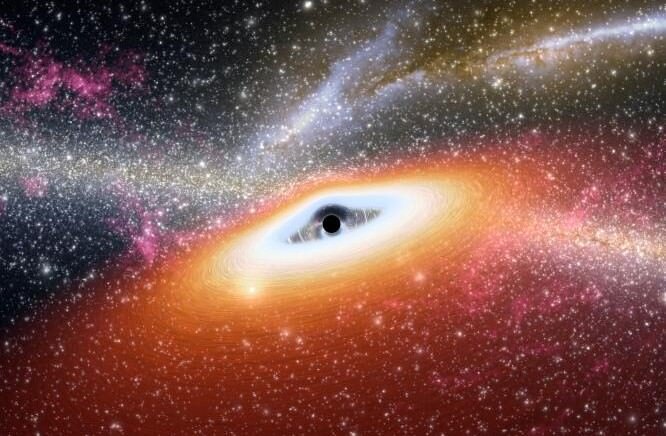
This artist’s conception illustrates a supermassive black hole (central black dot) at the core of a young, star-rich galaxy. Now astronomers have found a rogue SMBH travelling through space. Credit: NASA/JPL-Caltech
The paper is “A candidate runaway supermassive black hole identified by shocks and star formation in its wake.” The lead author is Pieter van Dokkum, Professor of Astronomy and Physics at Yale University. The paper is avaiable on the arXiv preprint server and hasn’t been peer-reviewed yet.
If you’ve never heard of a runaway SMBH, you’re not alone. SMBHs are normally locked into place at the centers of galaxies, and that’s where they stay. But scientists think that in rare circumstances SMBHs can escape their galaxies. In their paper, the authors explain how an SMBH can be cast out of its host galaxy.
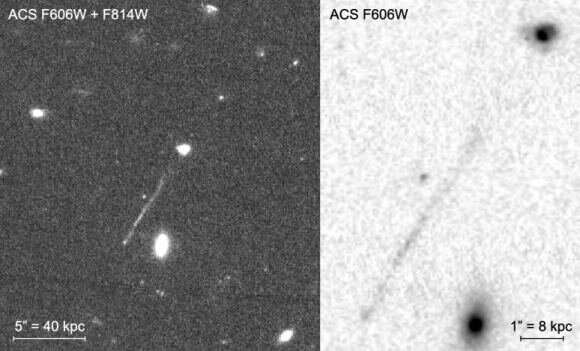
These images from the Hubble’s Advanced Camera for Surveys show the linear feature that may result from a rogue SMBH. Credit: van Dokkum et al. 2023
It always starts when galaxies merge. That leads to the formation of a binary SMBH at the center of the merger remnant. The binary SMBH can be very long-lived, surviving for as long as one billion years before merging. If during that time, a third SMBH reaches the galactic center, then a three-body interaction can give one of the SMBHs a velocity boost, and it can be driven from the galaxy.
But despite their theoretical underpinnings, finding these rogue SMBHs is difficult. Astronomers identified one of the best candidates in 2021, about 230 million light-years away. The authors noticed peculiar movement and velocity that indicated recent disruption. But they couldn’t conclude whether they saw an ongoing galaxy merger, a binary black hole system, or a gravitational-wave recoil event.
Astronomers recognize a couple of ways that they can identify a runaway SMBH. The easiest way is if the hole is actively absorbing material as an active galactic nucleus and can be identified by its luminosity. “For such objects,” the authors write, “the presence of an SMBH is not in doubt, but it can be difficult to determine whether they are ‘naked’ black holes or the nuclei of merging galaxies.”
Another way is by the stellar mass that the rogue hole drags along with it. When an SMBH is ejected, its massive gravitational power pulls some stars along with it. But without the luminosity from an AGN, the dimness makes identifying the hole and its stellar companions difficult from a great distance.
A third way that astronomers could recognize a potential rogue SMBH is by the effect it has on the diffuse gas in the circumgalactic medium (CGM) as it passes through it.
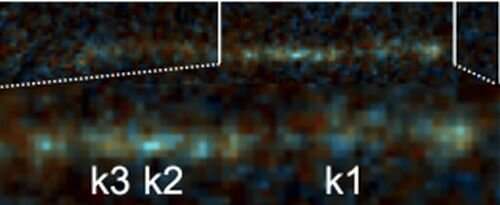
This image from the work shows three knots in the tail that are likely recently formed stars. The researchers found that the three stars fall within the correct ranges of metallicity, age, and dust content to conform with a rogue SMBH that left its galaxy about 39 million years ago. Credit: van Dokkum et al. 2023
“The interaction of a runaway supermassive black hole with the CGM can lead to the formation of a wake of shocked gas and young stars behind it,” the authors write. In their paper, they report the serendipitous discovery of a linear feature in images from the Hubble’s Advanced Camera for Surveys that could be one of these wakes.
When an SMBH travels through ionized hydrogen in the CGM, it produces a shock front with a long wake trailing behind it. In the wake, clouds of shocked gas can cool and form stars that look like knots in the trail. The researchers analyzed three of the knots in the linear feature and measured their ages and metallicity.
Theory and modeling show that the youngest stars formed in the wake should be younger than about 30 million years old. When the researchers measured their properties, they found that the three knots are within the age range laid out by models. They’re also within the range of metallicities and dust content.
If the host galaxy ejected an SMBH, the galaxy should show signs of disruption. SMBHs are extraordinarily massive, and that much mass can’t move through a galaxy without shaping it. The team examined the galaxy that spawned the rogue SMBH and found that its morphology was disrupted.
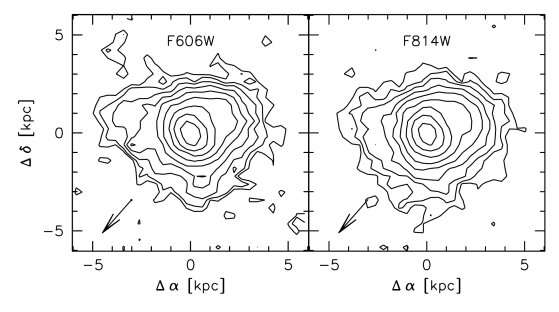
This figure from the research shows the morphology of the galaxy in F606W and F814W (Hubble filters.) The arrow indicates the direction of the linear feature. The galaxy is compact and shows irregular features, possibly indicating a recent merger and/or a connection to the linear feature. Credit: van Dokkum et al. 2023
There is, however, another possible explanation for the linear feature. It could be a black hole jet rather than a rogue SMBH. Under the right conditions, black hole jets can also shock gas in the CGM and lead to star formation. “There are two well-studied nearby examples of jets triggering star formation,” the authors state. One of them is called Minkowski’s Object.
The authors acknowledge the black hole jet explanation as a possibility, but they say there are too many problems with it. Visible emission lines aren’t a property of black hole jets, and there’s no evidence of nuclear activity. There’s also a problem with morphology. “A more serious issue is that the morphology of the feature does not match simulations or observations of jet-induced star formation,” the authors explain.
They settle on a runaway SMBH as the best explanation for the data and observations.
“The line ratios, colors, and the overall morphology are consistent with an ejected SMBH moving through the CGM at high speed while triggering star formation,” they write.
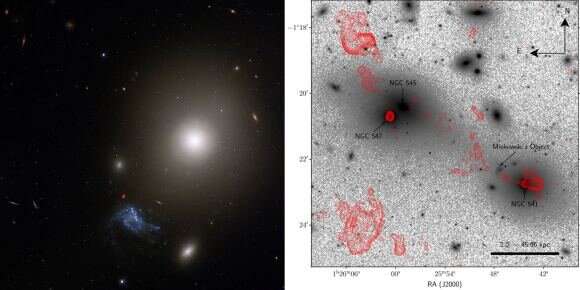
This image shows two views of Minkowski’s Object. On the left is a Hubble image showing MO in blue. The elliptical galaxy NGC 541 is above and to the right. A jet coming from NGC 541’s black hole is powering star formation in Minkowski’s Object. Credit: (L) NASA, ESA, and S. Croft (Eureka Scientific Inc.); Image Processing: Gladys Kober (NASA Goddard/Catholic University of America). (R) Sloan Digital Sky Survey/H. R. M. Zovaro et al.
Locating the black holes would be incontrovertible evidence for this conclusion. “The ‘smoking gun’ evidence for this scenario would be the unambiguous identification of the black holes themselves,” the researchers write. “The obvious places to look for them are A and B in Fig. 6.”
“These are candidates for ‘hyper compact stellar systems,’ SMBHs enveloped in stars and gas that escaped with them,” they explain.
The long feature in these observations is highly unusual, so it won’t be a surprise if it has an unusual cause. Only more observations can determine if rogue SMBHs are at work, and the JWST could provide them. “Deeper data, for instance, from the JWST NIRSPEC IFU, may show the expected broad, highly red- or blueshifted emission lines of ionized gas that is bound to the black holes themselves. Those data could also spatially resolve flows, shocks, and star formation near A,” the authors say, looking ahead.
And if there is one instance of runaway SMBHs creating these features, there will be others.
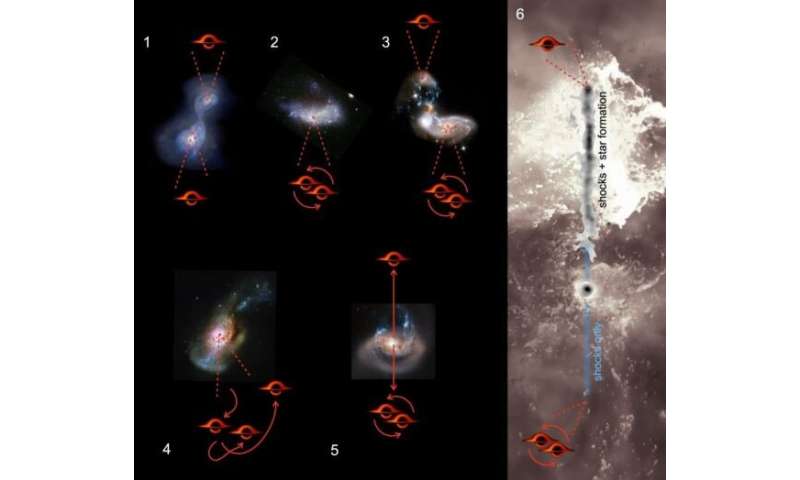
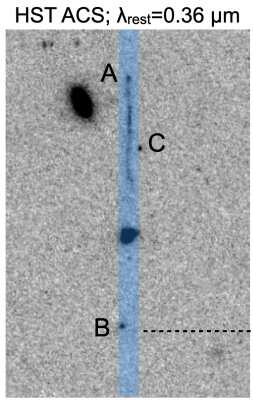
“Looking ahead, the morphology of the feature in the HST images is so striking that it should not be too difficult to find more examples if they exist. Future data from the Nancy Grace Roman telescope can be searched with automated algorithms,” they explain.
A rogue SMBH disconnected from its galaxy and roaming through the circumgalactic medium is a fascinating phenomenon. We’re only in the early stages of understanding SMBHs, how they’re linked with galaxy growth, and how they merge to produce gravitational waves.
To find that they can be kicked out of their host galaxies adds a layer of complexity only nature could come up with.
Source: phys.org





